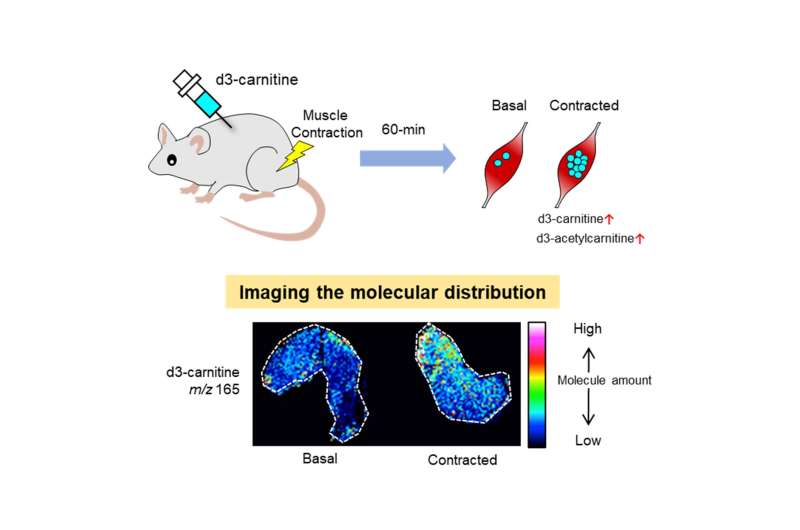This article has been reviewed according to Science X's editorial process and policies. Editors have highlighted the following attributes while ensuring the content's credibility:
fact-checked
peer-reviewed publication
trusted source
proofread
Scientists map the distribution of carnitine in muscle cells

Researchers from Tokyo Metropolitan University have developed a way of mapping the distribution of carnitine in skeletal muscle cells. Carnitine is a compound that helps transport fatty acids and reduce metabolic byproducts. They discovered that slow-type muscle fibers contained the most, and that activity promptly led to rises in acetylcarnitine, a product of the immediate response of carnitine contained in the cell. Their technique promises new insights into how muscle cells work.
Our muscles require energy to function. Much of this power is produced in the mitochondria inside cells, where fatty acids are converted into adenosine triphosphate (ATP), the chemical that fuels the vast array of other reactions which help our bodies work. Helping this along is a small compound called carnitine, which helps transport fatty acids into the mitochondria.
It is also responsible for lowering the levels of byproducts of the reaction, specifically acetyl CoA (coenzyme a) which can be toxic in high concentrations. Carnitine binds to acetyl CoA and becomes acetyl-carnitine, ensuring that metabolism works seamlessly. However, where exactly carnitine resides in muscle fiber cells, and how those levels change over time have remained difficult to study due to the difficulty of labeling it in a way that helps differentiate how much resides where, and how that changes.
Now, a team of researchers led by Assistant Professor Yasuro Furuichi have come up with a way of studying the distribution of carnitine in muscle fiber cells, and how it changes during metabolic processes. They used a version of carnitine which had some of its hydrogen replaced with deuterium, giving it a distinct signal when studied using mass spectrometry.
Mouse muscle fiber cells treated with this deuterated carnitine was rapidly frozen and cut into ultra-thin sections before undergoing a form of imaging where different parts of the section could be separately put through mass spectrometry, giving detailed information as to what kind of compounds reside where.
First, the team discovered that there was a higher concentration of carnitine in slow-type muscle fibers, fibers responsible for sustained force over longer periods of time than fast-type fibers. This is due to the fact that slow-type fibers contain more mitochondria. Furthermore, they applied electrical stimulation to the fibers to simulate muscle contraction before taking the data.
They found significantly elevated uptake of carnitine into the fibers, as well as an elevated level of acetyl carnitine. Importantly, this shows that carnitine contained in the cells responds very promptly as cells increase their activity.
The team's new method sheds light on a previously inaccessible level of detail regarding the biochemical processes that help muscles function. Carnitine itself is a popular dietary supplement, but its impact on muscular well-being is a topic of debate. Quantitative measurement of how it is taken up, localized, and metabolized in cells promises to illuminate the efficacy of therapies.
The study is published in the journal Heliyon.
More information: Yasuro Furuichi et al, Stable isotope-labeled carnitine reveals its rapid transport into muscle cells and acetylation during contraction, Heliyon (2023). DOI: 10.1016/j.heliyon.2023.e15281
Journal information: Heliyon
Provided by Tokyo Metropolitan University



















